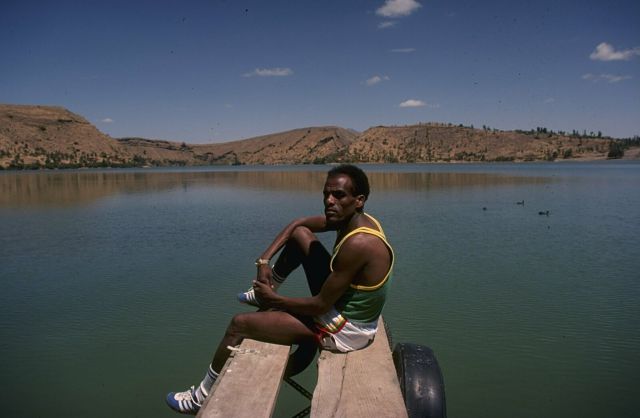 One year before Ethiopian Miruts Yifter won an Olympic bronze medal in Munich, Germany, and five years before he won two golds in Moscow, he miscounted laps in a race held in Durham, North Carolina [during the Pan-Africa – U.S.A. International Track Meet] in front of 52,000 fans. He would soon earn the moniker “Yifter the Shifter” for his ability to change speeds so rapidly in races. (Fansided)
One year before Ethiopian Miruts Yifter won an Olympic bronze medal in Munich, Germany, and five years before he won two golds in Moscow, he miscounted laps in a race held in Durham, North Carolina [during the Pan-Africa – U.S.A. International Track Meet] in front of 52,000 fans. He would soon earn the moniker “Yifter the Shifter” for his ability to change speeds so rapidly in races. (Fansided)
Fansided
50 years ago, Duke University hosted the experimental Pan-Africa – U.S.A. International Track Meet, looking to change a legacy of structural racism.
One year before Ethiopian Miruts Yifter won an Olympic bronze medal in Munich, Germany, and five years before he won two golds in Moscow, he miscounted laps in a race held in Durham, North Carolina. As a result, American distance running icon, Steve Prefontaine, took the title at the Pan-Africa – U.S.A. International Track Meet in front of 52,000 fans. Yifter irritated his competitors, shifting between positions throughout the race, before mistakenly using his final gear in the penultimate lap. He would soon earn the moniker “Yifter the Shifter” for his ability to change speeds so rapidly in races.
After the race, a frustrated Yifter explained that he was accustomed to hearing bells, not a gun, to signal the final lap, and did not see the lap counter. Jean Claude Ganga, a Congolese sports administrator and the selected African team manager for this particular competition, explained further, “‘In some countries, it’s a gong, gong, in others, it’s a bing, bing, bing. Here it’s a boom. He did not know this.”
This would be one of several moments of cultural reckoning 50 years ago, when athletes from across the continent were invited to North Carolina to compete at the Wallace Wade Stadium at Duke University on July 16-17, 1971.
As sport is positioned to do, the Pan-Africa – U.S.A. International Track Meet was meant to disseminate ideas and feelings of cultural cohesion. But for many, using the Pan-African namesake to advertise the event just a few short years after Black students occupied a central Duke Administration building to make demands in response to the racism they felt at the newly integrated University, and with several African countries still under colonial rule, cohesion seemed like an obvious ruse.
At the competition, Pan-Africanism had two opposing connotations. For some — namely the organizers and most spectators — it simply described the structure of the meet. Athletes from across the African continent competed as one team against athletes from the U.S. For others, most notably the Black activists who attended the meet to publicize racial oppression omnipresent in the South, Pan-Africanism was an ideology focused on uniting all people of African descent within and beyond the continent. It was, and is, an anti-imperialist and anti-racist way of organizing politics in the world. And it changed how some understood the different teams on the track and in the field.
“We decided to create this huge scoreboard and the idea was any time any Black person won points whether they were from Africa or the United States we gave those points to Africa,” civil rights activist, academic, and education reform leader, Howard Fuller, told FanSided.
Fuller, along with other students and members of the Malcolm X Liberation University (MXLU) that he helped found knew they would need to take advantage of the large staging of such an event to make a statement and espouse the values of Pan-Africanism. The University was created mostly in response to the discrimination Black students faced in Duke’s early years of integration, and the structural racism felt in Durham and beyond.
“When we learned about the track meet the first thing we did was we met the people from Africa when they got off the plane,” Fuller explains. “We had made up these packets telling them about the oppression of Black people in Durham and North Carolina. And then with the score card we brought drums to the meet and were drumming the whole time. So we turned an athletic event into a political event.”
Pre-meet dynamics around Duke University
The meet was the brainchild of Dr. LeRoy T. Walker, the head coach of North Carolina Central University (NCCU), a historically black university founded in the early 20th century. Walker coached dozens of Olympians before and after his time at NCCU, and critically forged a close relationship with Duke’s Cross Country and Track and Field Coach, Al Buehler, in order to find adequate facilities for his athletes.
One of Walker’s athletes, Lee Calhoun, only had access to five hurdles and a poorly maintained track that could easily turn an ankle. Calhoun, who went on to win Olympic Gold Medal in the 110-meter hurdles at the 1956 and 1960 Olympic Games, as well as other several would-be Olympians, would soon be snuck into Duke’s segregated campus to practice in safer conditions.
—
Join the conversation on Twitter and Facebook.

























